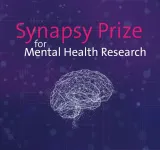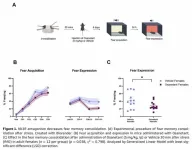(Press-News.org) A study led by researchers at Mass General Brigham suggests that, when it comes to cardiovascular health, food timing could be a bigger risk factor than sleep timing
Numerous studies have shown that working the night shift is associated with serious health risks, including to the heart. However, a new study from Mass General Brigham suggests that eating only during the daytime could help people avoid the health risks associated with shift work. Results are published in Nature Communications.
“Our prior research has shown that circadian misalignment – the mistiming of our behavioral cycle relative to our internal body clock – increases cardiovascular risk factors,” said senior author Frank A.J.L. Scheer, PhD, a professor of Medicine and director of the Medical Chronobiology Program at Brigham and Women’s Hospital, a founding member of the Mass General Brigham healthcare system. “We wanted to understand what can be done to lower this risk, and our new research suggests food timing could be that target.”
Animal studies have shown that aligning food timing with the internal body clock could mitigate the health risks of staying awake during the typical rest time, which prompted Scheer and his colleagues to test this concept in humans.
For the study, researchers enlisted 20 healthy young participants to a two-week in-patient study at the Brigham and Women’s Center for Clinical Investigation. They had no access to windows, watches, or electronics that would clue their body clocks into the time. The effect of circadian misalignment could be determined by comparing how their body functions changed from before to after simulated night work.
Study participants followed a “constant routine protocol,” a controlled laboratory setup that can tease apart the effects of circadian rhythms from those of the environment and behaviors (e.g., sleep/wake, light/dark patterns). During this protocol, participants stayed awake for 32 hours in a dimly lit environment, maintaining constant body posture and eating identical snacks every hour. After that, they participated in simulated night work and were assigned to either eating during the nighttime (as most night workers do) or only during the daytime. Finally, participants followed another constant routine protocol to test the aftereffects of the simulated night work. Importantly, both groups had an identical schedule of naps, and, thus, any differences between the groups were not due to differences in sleep schedule.
The investigators examined the aftereffects of the food timing on participants’ cardiovascular risk factors and how these changed after the simulated night work. Researchers measured various cardiovascular risk factors, including autonomic nervous system markers, plasminogen activator inhibitor-1 (which increases the risk of blood clots), and blood pressure.
Remarkably, these cardiovascular risk factors increased after simulated night work compared to the baseline in the participants who were scheduled to eat during the day and night. However, the risk factors stayed the same in the study participants who only ate during the daytime, even though how much and what they ate was not different between the groups—only when they ate.
Limitations of the study include that the sample size was small, although of a typical size for such highly controlled and intensive randomized controlled trials. Moreover, because the study lasted two weeks, it may not reflect the chronic risks of nighttime versus daytime eating.
A strength is that the study participants’ sleep, eating, light exposure, body posture, and activity schedule were so tightly controlled.
“Our study controlled for every factor that you could imagine that could affect the results, so we can say that it’s the food timing effect that is driving these changes in the cardiovascular risk factors,” said Sarah Chellappa, MD, MPH, PhD, an associate professor at the University of Southampton, and lead author for the paper.
While further research is necessary to show the long-term health effects of daytime versus nighttime eating, Scheer and Chellappa said the results are “promising” and suggest that people could improve their health by adjusting food timing. They add that avoiding or limiting eating during nighttime hours may benefit night workers, those who experience insomnia or sleep-wake disorders, individuals with variable sleep/wake cycles, and people who travel frequently across time zones.
Authorship: In addition to Scheer, Mass General Brigham authors include Lei Gao, Jingyi Qian, Nina Vujovic, Peng Li, and Kun Hu.
Disclosures: Scheer served on the Board of Directors for the Sleep Research Society and has received consulting fees from the University of Alabama at Birmingham and Morehouse University.
Funding: This study was funded by Grant number NIH R01HL118601 (ClinicalTrials.gov number: NCT02291952), 1UL1TR001102 and 1UL1TR002541-01. The funder had no role in the design of the study; in the collection, analyses or interpretation of data; in the writing of the manuscript, or in the decision to publish it.
Paper cited: Chellappa SL et al. “Daytime eating during simulated night work mitigates changes in cardiovascular risk factors: secondary analyses of a randomized controlled trial” Nature Communications DOI: 10.1038/s41467-025-57846-y
For More Information:
Biological Clock Plays Critical Role in Driving Teens’ Late Eating Habits | Mass General Brigham
Daytime Eating May Benefit Mental Health | Mass General Brigham
Study Finds Well-Timed Meals Reduce Risk of Glucose Intolerance Despite Mistimed Sleep
###
About Mass General Brigham
Mass General Brigham is an integrated academic health care system, uniting great minds to solve the hardest problems in medicine for our communities and the world. Mass General Brigham connects a full continuum of care across a system of academic medical centers, community and specialty hospitals, a health insurance plan, physician networks, community health centers, home care, and long-term care services. Mass General Brigham is a nonprofit organization committed to patient care, research, teaching, and service to the community. In addition, Mass General Brigham is one of the nation’s leading biomedical research organizations with several Harvard Medical School teaching hospitals. For more information, please visit massgeneralbrigham.org.
END
(Philadelphia, PA) – Calcium transport into and out of mitochondria – the powerhouses of cells – is central to cellular energy production and cell death. To maintain the balance of calcium within these powerhouses, cells rely on a protein known as the mitochondrial sodium-calcium exchanger, or NCLX. Now, in new research, scientists at the Lewis Katz School of Medicine at Temple University have discovered a novel regulator of NCLX activity, a protein called TMEM65, which helps move ...
Mental health is in crisis worldwide. While the neurosciences are advancing rapidly, psychiatry still struggles to diagnose and effectively treat many disorders. The Synapsy Center for Neuroscience and Mental Health Research at the University of Geneva, Switzerland, is launching a new international prize to reward those who bring these two worlds closer together.
A new research model is needed
Depression, schizophrenia, anxiety or bipolar disorders: psychiatric illnesses affect hundreds of millions of people worldwide and are among the leading causes of disability, suffering and mortality. Yet clinical advances remain limited. Many diagnoses ...
A new study maps how specific lactic acid bacteria can enhance both the flavour and nutritional quality of plant-based dairy alternatives. The findings may have wide-reaching perspectives for the further development of sustainable foods.
Plant-based dairy alternatives – such as soy, oat, and almond drinks – are produced without animal ingredients for consumers seeking plant-based substitutes for milk and yoghurt. However, many of these products have the similar shortcomings: flavours that do not always appeal ...
A new paper in Nicotine & Tobacco Research, published by Oxford University Press, finds that a 2018 U.S. ban on smoking in public housing led to a reduction in hospitalizations for cardiovascular problems.
Tobacco use and exposure to secondhand smoke is a leading cause of preventable death in the United States. Some 480,000 Americans die every year due to tobacco. While the prevalence of adults exposed to secondhand smoke decreased dramatically between 1988 and 2014 (from 87.5% to 25.2%), about 58 million non-smokers in the U.S. experience tobacco smoke, primarily at home. Beginning in the early 2000s, ...
MONTRÉAL, Québec, Canada, 8 April 2025 – In a powerful and deeply reflective Genomic Press Interview, published in Brain Medicine, Dr. Romina Mizrahi, Professor of Psychiatry at McGill University and Principal Investigator of the CaTS (Clinical and Translational Sciences) Lab at the Douglas Research Center, charts a new path forward in psychiatric research—one that begins at the molecular level.
Harnessing the power of positron emission tomography (PET), Dr. Mizrahi’s work sheds light on the invisible workings of the human brain. Where traditional psychiatric diagnosis often relies on subjective symptom clusters, her approach integrates in-vivo imaging, ...
BARCELONA, Catalonia, Spain, 8 April 2025 – A new Brevia (peer-reviewed research report) published in Brain Medicine reveals that a single dose of the drug Osanetant, administered shortly after a traumatic event, significantly dampens fear expression in female mice. The findings provide strong preclinical support for using Nk3R antagonism as a sex-specific, time-sensitive intervention to reduce the risk of posttraumatic stress disorder (PTSD).
Targeting fear memory at its roots
Fear memory is a core feature of PTSD, especially when neutral cues become emotionally ...
For hundreds of years, the Amazon has been exploited for its gold. Today, the precious metal is just as sought after, but the remaining tiny gold particles are much harder to find. Mining often happens in artisanal and small-scale mining operations that release mercury (Hg) into the air, polluting the environment and harming human health.
An international team of researchers has now examined tree rings of species native to the Peruvian Amazon to determine if trees could be used to show approximately where and when atmospheric mercury was released.
“We show that Ficus insipda tree cores can be used as a biomonitor for characterizing ...
The research team led by Dr. Jongwon Yoon, Dr. Jeongdae Kwon, and Dr. Yonghoon Kim from the Energy & Environmental Materials Research Division at the Korea Institute of Materials Science (KIMS), has successfully developed the world’s first ammonia (NH₃) gas sensor based on a copper bromide (CuBr) film that can be fabricated through a simple solution process at low temperatures. This breakthrough technology not only enables sensor flexibility, ultra-sensitivity, and high selectivity but also significantly reduces manufacturing costs.
Ammonia gas sensors detect airborne ammonia and are utilized in indoor and outdoor ...
Hot flashes, mood swings, weight gain and insomnia are all signs of hormonal changes and symptoms of menopause, when a woman no longer has menstrual cycles. They can also signal perimenopause, when the body is preparing for this next season of life.
“Perimenopause is when the menstrual cycle has started to change, and it is persistent,” explained Lauren Baker, DO, an obstetrics and gynecology physician at The Ohio State University Wexner Medical Center and certified practitioner with the Menopause Society. “The formal definition is periods fluctuate by at least seven days for at least 10 months.”
A new survey by Ohio State ...
SINGAPORE – Researchers from the Agency for Science, Technology and Research (A*STAR) and the National Healthcare Group (NHG) have jointly pioneered an innovative imaging technique combining Multispectral Optoacoustic Tomography (MSOT) with artificial intelligence (AI) that could significantly improve the diagnosis and treatment of basal cell carcinoma (BCC), the most common form of skin cancer worldwide.
This advanced technique uses photoacoustic imaging (PAI), enhanced by an automated segmentation algorithm, to provide real-time, high-resolution, three-dimensional (3D) images of skin tumours. By accurately mapping tumour boundaries, ...





